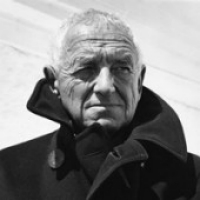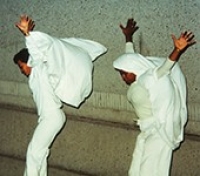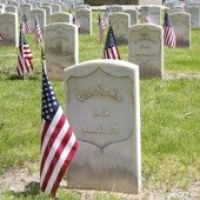Established in 2003, the Wyeth Foundation for American Art lectures, conferences, and symposia are biennial programs hosted by the Center for Advanced Study in the Visual Arts, National Gallery of Art, and supported by the Wyeth Foundation for American Art. Participants are chosen on the basis of their outstanding contributions to the study of and scholarship on American art.
Wyeth Foundation for American Art Programs

Andrew Wyeth, Maine, 1981. © Bruce Weber
Wyeth Symposia in American Art
January 20, 2023
Staking Claim: Latinx Art and US American Experiences

Freddy Rodríguez, Paradise for a Tourist Brochure, 1990, acrylic, sawdust, and newspaper collage on canvas, Gift of Funds from The Ahmanson Foundation, and Patrons' Permanent Fund, 2022.45.1
The symposium highlighted the complexities of Latinx art in the United States. It was organized by the Center for Advanced Study in the Visual Arts in close collaboration with E. Carmen Ramos, Chief Curatorial and Conservation Officer at the National Gallery of Art, and Adriana Zavala, Andrew W. Mellon Professor at the Center and Associate Professor of History of Art and Architecture and Studies in Race, Colonialism, and Diaspora at Tufts University.
Presentations and discussions included Taína Caragol, Kency Cornejo, Deborah Cullen-Morales, Robb Hernández, Yasmin Ramirez, Tere Romo, Juan Sánchez, Susanna Temkin, and Adriana Zavala.
December 4–11, 2020
Feminism in American Art History

Unidentified artist, Flora, c. 1796–1820, cut paper on millboard with pen and brown ink, 14 x 13 in. Stratford Historical Society, Stratford, CT
Presentations by Kirsten Pai Buick, Aruna D’Souza, Cecilia Fajardo-Hill, Lisa Farrington, Jessica Horton, Jenny Lin, Helen Molesworth, and Jennifer Van Horn.
Program (PDF 610KB)
March 16–17, 2017
The African American Art World in Twentieth-Century Washington, DC

Alma Thomas, Red Rose Cantata, 1973, acrylic on canvas, Gift of Vincent Melzac, 1976.6.1
Speakers included Rhea L. Combs, Gwendolyn H. Everett, Paul Gardullo, Tuliza Fleming, Jacqueline Francis, Lauren Haynes, Amy Kirschke, Robert G. O'Meally, Richard J. Powell, Jacquelyn D. Serwer, Elsa Smithgall, Jeffrey C. Stewart, John A. Tyson, and Tobias Wofford. Session moderators were Kinshasha Holman Conwill, Charles Brock, and Huey Copeland. The symposium also featured a panel of artists moderated by Ruth Fine and including Lilian Thomas Burwell, Floyd Coleman, David C. Driskell, Sam Gilliam, Keith A. Morrison, Martin Puryear, Sylvia Snowden, and Lou Stovall.
Program (PDF 433KB)
October 19, 2018
The American Still Life
This conference considered the genre of still life in American art in various media including painting, sculpture, photography, and printmaking. Papers addressed works that range in time from the colonial period to the present day.
Speakers included Maggie Cao, Nika Elder, Ellery Foutch, Diana Greenwald, Shana Klein, Ashley Lazevnick, Mark Mitchell, and Amy Werbel.
Program (PDF 421KB)
Wyeth Lectures in American Art
2023
Latinx Art and the Intimacy of Dislocation
Roberto Tejada, University of Houston

Celia Álvarez Muñoz, Petrócoatl, 1992, cibachrome print, 20 x 16 in., Courtesy the artist
Artists, lawmakers, and the media continue to grapple with a category problem that inadequately defines Latine/a/o/x experience as well as the cultural contradictions encapsulated in an archive of visual practices that spans well over five decades. If we look closely at an intergenerational cross section of artists and their work, we can begin to compare multimedia narratives and geographical particulars, encouraging a meta-historical view.
The colonization of the Caribbean and Americas, together with its present-day vestiges, endures as a persistent theme for Latinx artists who seek to address the social and ecological catastrophes that constitute the contemporary condition.
This talk considers visual encounters unique to Latinx lifeways but that contest US American geopolitics and the uneven distributions of modern life. A corpus of Latinx art can be seen as a crossway of intersecting cultural and political attributes—intimacies in dislocation that inflect a dissenting perspective and overturn the casual or cursory cultural account.
2021
Prioritizing Indigenous Communities and Voices: Curating in This Time
Patricia Marroquin Norby, The Metropolitan Museum of Art

Patricia Marroquin Norby, The Metropolitan Museum of Art
Patricia Marroquin Norby (Purépecha), associate curator of Native American art at the Metropolitan Museum of Art (the Met), presents this year’s Wyeth Lecture in American Art. Dr. Norby’s lecture will focus on her forthcoming book Water, Bones, and Bombs and her curatorial practices that affirm Indigenous representations. She will share her vision for and approaches to collecting, presenting, and interpreting Native American art at the Met and beyond.
In September 2020, Dr. Norby made international history with her appointment at the Met, becoming the first full-time curator of Native American art in the museum’s 150-year history. Since then Dr. Norby has broken institutional barriers by engaging bold, refreshing, community-centered approaches that foreground Indigenous voices and experiences within the Met’s collections, exhibitions, and programs. Her curatorial vision and strategies have been celebrated by the New York Times, PBS, Forbes magazine, and Bitch Media, and she has been described as “a new voice in an old institution” by the Santa Fe New Mexican’s arts and culture magazine, Pasatiempo. Dr. Norby previously served as senior executive and assistant director of the National Museum of the American Indian New York and as director of the D’Arcy McNickle Center for American Indian and Indigenous Studies at the Newberry, in Chicago.
2019
Art Is an Excuse: Conceptual Strategies, 1968–1983
Kellie Jones, Columbia University

Senga Nengudi (right) and Maren Hassinger (left), Flying, 1982 Performance, Los Angeles. African American Performance Art Archive
This lecture is based on a book in progress that looks at international conceptual art networks and the making of global community in the late twentieth century.
The dematerialized framework of conceptual art engaged systems theory, which gained currency in the 1960s. Involving information-based technologies and the impact on labor, such schemas made conceptual art legible as artistic practice, particularly its iterations as interaction or performance, which all but replaced objects as art. Systems theory was also seen in the idea of interrelation as part of a living ecosystem, composed through the interdependence of human beings worldwide.
The larger project encompasses art incorporating language and text along with multimedia installations that charted the annihilation of the traditional object. The lecture singles out performance art, which brought focus to the temporal as a reaffirmation of human existence. A piece could be "placed" anywhere and everywhere and unfolded in the here and now. These characteristics allowed performance to be dispersed effortlessly into the flow of everyday life as spectacle or political act. The lecture will consider moments in the global reach of performance art in the 1970s in locales from Mexico City to London to Los Angeles, considering projects by artists including Felipe Ehrenberg, Lourdes Grobet, Adrian Piper, Senga Nengudi, and David Lamelas.
2017
The Panorama and the Globe: Expanding the American Landscape in World War II
Cécile Whiting, University of California, Irvine
During World War II, maps that pictured troops advancing and retreating across national borders, along with photographs and newsreels documenting death and destruction in locations around the world (including the naval base of Pearl Harbor, the tropical rain forests of Guadalcanal, and the beaches of North Africa), prompted a change in painted representations of landscape in the United States. Cécile Whiting's research focuses on how American artists recast the terms of landscape painting as it had been practiced in the 1930s, broadening its scope from the local to the international and from the pastoral to the antipastoral. The lecture analyzes the ways in which artists depicted landscapes joining the national and the international. In particular, it examines paintings by Thomas Hart Benton and John Steuart Curry, who adopted a panoramic mode, literally and metaphorically widening the horizontal scope of their paintings to encompass both the United States and Europe. As a counterpoint, it discusses The Rock, the painting in which Peter Blume attempted to fit the globe into his landscape.
2015
The Art of the Name: Soldiers, Graves, and Monuments in the Aftermath of the Civil War
Kirk Savage, University of Pittsburgh

Soldiers' Lot at Allegheny Cemetery, Pittsburgh, Pennsylvania, 1874–1927. Photo: Kirk Savage
On a scale unprecedented in U.S. history, the Civil War led to a massive physical displacement of bodies in life and in death. Equally if not more troubling, however, the war caused a shocking metaphysical displacement of bodies from their names, creating legions of the “unknown” (bodies without names) and the “missing” (names without bodies). This lecture examines how art was invoked and deployed to come to terms with what Savage calls the "metadata crisis" of the war dead. One side of the story is the long postwar effort to reattach names to bodies, which had far-reaching impacts on the American landscape, generating a national cemetery system and revolutionizing the gravestone industry. The other side of the story is the deliberate detachment of names from bodies and the innovation of ever-longer lists of names in bronze and stone that would eventually culminate in the enigmatic abstraction of the Vietnam Veterans Memorial. At once material and immaterial, the art of the name provides a lens through which to plumb the transformations in personal and national identity wrought by the catastrophe of mass warfare.
2013
Reversing American Art
Jennifer L. Roberts, Harvard University
This lecture explores one of the fundamental operations of printmaking—reversal—in order to trace its impact on American art across a spectrum of media. Behind every print lies a matrix (from the Latin for mother): a plate or block or stone or screen from which the print has been "pulled." And in most printing processes, the final print is a reversed version of the matrix. Although reversal may seem at first to be a simple geometrical switching operation, its material and philosophical complexity is profound; indeed, one may posit a kind of "negative intelligence" that informs any work of art that deploys reversal. Given its status as the result of contact between surfaces and its connection to symmetry, orientation, and handedness, reversal creates its own poetics of bodily experience. Inasmuch as the reverse lurks as the invisible "other side" of any form. It is often coincident with mystery or secrecy. In its close association with reproduction, reversal informs thinking about patterning, generation, and fecundity. And it embodies critique, negation, and the visualization of alternative dimensions and forms.
To focus on reversal is to open up new ways of thinking about connections among the fine, decorative, and industrial arts in America, not least because so many prominent American artists from the eighteenth through the twentieth century had backgrounds in print and printmaking. "Apprenticed as an engraver"; "trained as a lithographer"; "found initial success as a commercial artist": such are the typical preludes of American artists' biographies. A rigorous analysis of reversal offers an opportunity to expand the adventure of print from the preludes into the main narratives of the stories we tell about American art. The lecture addresses reversal in several contexts, from the nature prints of Joseph Breintnall in the 1730s to the handprints of Jasper Johns in the 1960s, with a core focus on the later nineteenth century in the work of James McNeill Whistler and the American trompe-l'oeil painters.
2011
Between the Lines: Philip Guston and “Bad Painting”
Bryan J. Wolf, Stanford University
In the years between 1967 and 1970, Philip Guston scandalized the New York art world by renouncing abstraction and turning instead to figurative modes of painting characterized by cartoonish images that mixed Ku Klux Klan hoods, idioms of popular culture, and a private vocabulary of cigars, light bulbs, legs, shoes, and other assorted—and often hairy—body parts. Buried within these often outlandish works are three recurring concerns: questions of pilgrimage, revelation, and epiphany that link Guston to Hudson River School painting of the nineteenth century; a covert interest in writing as a cultural logic that informs his painting practices; and an obsessive focus on line that distinguishes his art from the drips and gestural forms of Jackson Pollock. Ultimately, each of these concerns points to what can be seen as the real focus of Guston’s figurative work: the history and memory of the Holocaust.
2009
Minstrelsy “Uncorked”: Thomas Eakins’ Empathetic Realism
Richard J. Powell, Duke University
The lecture focuses on Thomas Eakins (1844–1916) as uniquely empathetic among the many 19th-century artists who depicted African American performance and entertainment. Eakins’ Negro Boy Dancing (1887; Metropolitan Museum of Art) shows a young banjo player, an elderly teacher, and an adolescent dancer, evoking the American rage for the form of musical theater known as minstrelsy. Eakins' watercolor, along with two oil-on-board studies at the National Gallery of Art, challenged the tendency of minstrelsy to employ racial ridicule and physical exaggeration. Instead, Powell argues, Eakins adhered to a painterly realism as well as his own brand of empathy and ethics.
2007
Ground Swell: Edward Hopper in 1939
Alexander Nemerov, Yale University (now at Stanford University)
Edward Hopper’s paintings often show people and places in states of enigmatic isolation, loneliness, and contemplation. These are among the fabled Hopper themes—so fabled it would hardly seem possible to go beyond them to give another account of his art. Focusing on one Hopper painting, Ground Swell of 1939, the lecture tries to provide a thicker, denser, more surprising story of what it meant for Hopper to make a painting, especially in the year 1939. The lecture was presented in conjunction with the exhibition Edward Hopper.
2005
Thomas Eakins and the “Grand Manner” Portrait
Kathleen A. Foster, Philadelphia Museum of Art
Codified in the late eighteenth century as a full-length, life-size portrait with impressive costume and attributes of rank and identity, the Grand Manner portrait evolved in the nineteenth century to suit the status-consciousness of a new, bourgeois era. Thomas Eakins (1844–1916), born and educated in Philadelphia and trained at the École des Beaux-Arts in Paris, absorbed the conventions of Grand Manner portraiture from baroque Spanish and Dutch works, from the English tradition of Sir Joshua Reynolds and Gilbert Stuart, and from the new naturalism of contemporary French art. Returning from Europe to Philadelphia in 1870, he launched a career as a figure painter that was, as Elizabeth Johns has argued, based on portraiture in many guises.
Eakins painted about two hundred fifty finished portraits in his lifetime (apart from portrait-related figure subjects), most of which depict the sitter at life size but on a small canvas that shows less than half the figure. But from the very outset of his career, and with increasing frequency after 1889, he essayed full-length portraits in the Grand Manner. Between 1870 and 1909, when he all but ceased painting, Eakins produced 36 full-length portrait figures, either seated or standing. A closer look at the choice and treatment of these relatively few sitters teaches us much about Eakins, his methods, and his values. If, as Oscar Wilde remarked, every great portrait is a picture of the artist, this “grand” series reveals in the most ambitious format the identity of the artist, covertly buried in the elaborate perspective coordinates of each composition, or enacted in a private pantheon of colleagues—artists, scientists, and teachers—that embody his grandest aspirations and mirror his sense of self.
2003
Friends and Rivals: Copley, West, Peale, Trumbull, and Stuart
Jules David Prown, Yale University
John Singleton Copley and Benjamin West were born in 1738; Charles Willson Peale, some two and one-half years later. Gilbert Stuart and John Trumbull, born in 1755 and 1756, respectively, belonged to the next generation. Their paths crossed and recrossed throughout their uniformly long lives. They formed friendships, influenced each other both through their art and personally, competed for clients, and eventually drifted apart, or, in the case of Copley and West, became bitter enemies. The lecture focuses on the artists' personal and professional encounters and interactions to tell the story of how they affected each other's lives and work.







